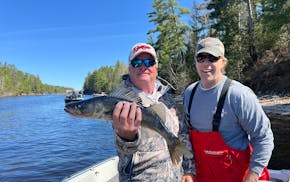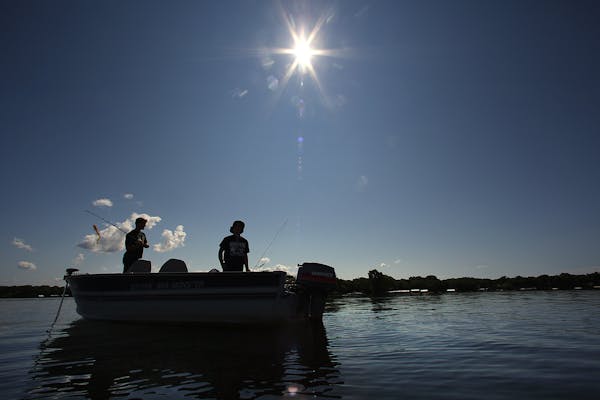Long overdue, a plan to stop invasive carp from swimming upstream in the Mississippi River toward Minnesota waters is in the making.
On Tuesday, the Lessard-Sams Outdoor Heritage Council (LSOHC) will consider funding for a deterrent at Lock and Dam 5 in the Mississippi. The deterrent's intent would be to keep silver and other invasive carp south of that point.
University of Minnesota professor and invasive carp expert Peter Sorensen has warned for years that the lack of a deterrent — some call it a barrier — at Lock and Dam 5 virtually ensures that, sooner or later, breeding populations of these fish will reach Lake Pepin, the St. Croix River and other Minnesota waters.
"Doing nothing, in my view, is environmentally irresponsible," Sorensen told me in an interview published Feb. 15.
Yet the carp action plan developed by the Department of Natural Resources (DNR) in 2014 didn't call for a Lock and Dam 5 deterrent, and the agency's recent updating of that plan suggested deterrent construction could begin — if it's undertaken at all — as far away as 2028.
That's too late, Sorensen believes.
"If you know a train is coming toward you and you can accurately estimate its speed, your two choices are stopping the train — in this case by building a deterrent — or jumping off the track," he said. "That's where we're at."
Enter now the LSOHC, a 12-member citizen-legislative council that recommends spending from the state's Outdoor Heritage Fund, one of four money pots created by passage in 2008 of the Clean Water, Land and Legacy Amendment.
Various LSOHC members, including chair David Hartwell, as well as Rep. Leon Lillie, DFL-North St. Paul, and Senator Foung Hawj, DFL-St. Paul, are said to support installing a carp deterrent at Lock and Dam 5.
They and others believe a deterrent, together with carp-capturing efforts the DNR already undertakes downriver of Lock and Dam 5, is the best way to protect Minnesota waters from invaders that not only threaten lake and river ecosystems, but also boating, fishing, swimming, and other types of water recreation.
The LSOHC would have considered funding a Lock and Dam 5 deterrent years ago, some council members say. But the DNR never brought a proposal to the council.
Now — thanks in part to a $12 million windfall the council has to appropriate — the carp-deterrent stars have aligned in ways that were unimaginable even a month ago, and the DNR and the U.S. Fish & Wildlife Service (FWS) on Tuesday will jointly propose that the LSOHC fund a Lock and Dam 5 carp deterrent.
Representatives of the Army Corps of Engineers and the U.S. Geological Survey also are expected to attend the Tuesday meeting.
Approval of the DNR-FWS deterrent proposal by the council on Tuesday is important because its other conservation funding recommendations, totaling $181 million, are moving through the state Legislature. The carp deterrent plan would have to be amended to the recommendations to gain approval in the current legislative session.
If the LSOHC supports the deterrent idea and the Legislature follows suit, the $12 million will be available for five years beginning July 1. A detailed plan must be submitted to the LSOHC before funds are disbursed, however, outlining how the money will be spent. Follow-up accomplishment plans also are required.
A key assumption in the plan is that the Corps of Engineers will award a research permit for the deterrent — a process that apparently can be expedited.
The deterrent likely will be similar to one manufactured in Britain that the FWS successfully placed in a Kentucky lock. Installation can only occur in winter, between Mississippi River shipping seasons.
An aside:
If the deterrent funding is approved, a significant share of the credit should go to the tens of thousands of hunters and anglers — and others — who insisted before passage in 2008 of the Legacy Amendment that a citizen-led council be established to recommend appropriations from the Outdoor Heritage Fund.
Memories of the Legislature ripping off money from lottery proceeds that Minnesota voters believed were designated for conservation were still fresh in the minds of sportsmen and sportswomen during the run-up to passage of the Legacy Amendment. Sportsmen and women had to be convinced that money flowing from the amendment wouldn't go directly to the DNR and wouldn't be distributed solely at the whim of legislators.
Unless those provisions were met, many hunters and anglers said, they wouldn't vote for the Legacy Amendment.
Thus the LSOHC was born.
This isn't to diminish the importance, ultimately, of the broad coalition, including environmentalists — the group's rallying cry, after all, was "Guns and Greens Working Together" — that joined to gain the amendment's passage. The addition of arts and culture supporters to the alliance also was critical. But it was the insistence of hunters and anglers — an effort led by Garry Leaf, a volunteer, among many others — that a citizen-legislative council be established that set the stage for the amendment's approval by voters and laid the groundwork for the more than 1,500 conservation projects the LSOHC has recommended for funding.
Whether funding of a much-needed — and much-delayed — invasive carp deterrent at lock and Dam 5 will be the LSOHC's latest, and perhaps most important, success will be determined Tuesday. The public can view the 11 a.m. meeting online at bit.ly/LEScarp.
Stay tuned.

Anderson: In early June, Minnesota fish are begging to be caught. Won't you help?

Anderson: Tails wagging, DNR officers' dogs find lost people and missing evidence
Anderson: Punish poachers more
Anderson: The Chainsaw Sisters Saloon is gone, but the Echo Trail is still a pathway to possibilities



